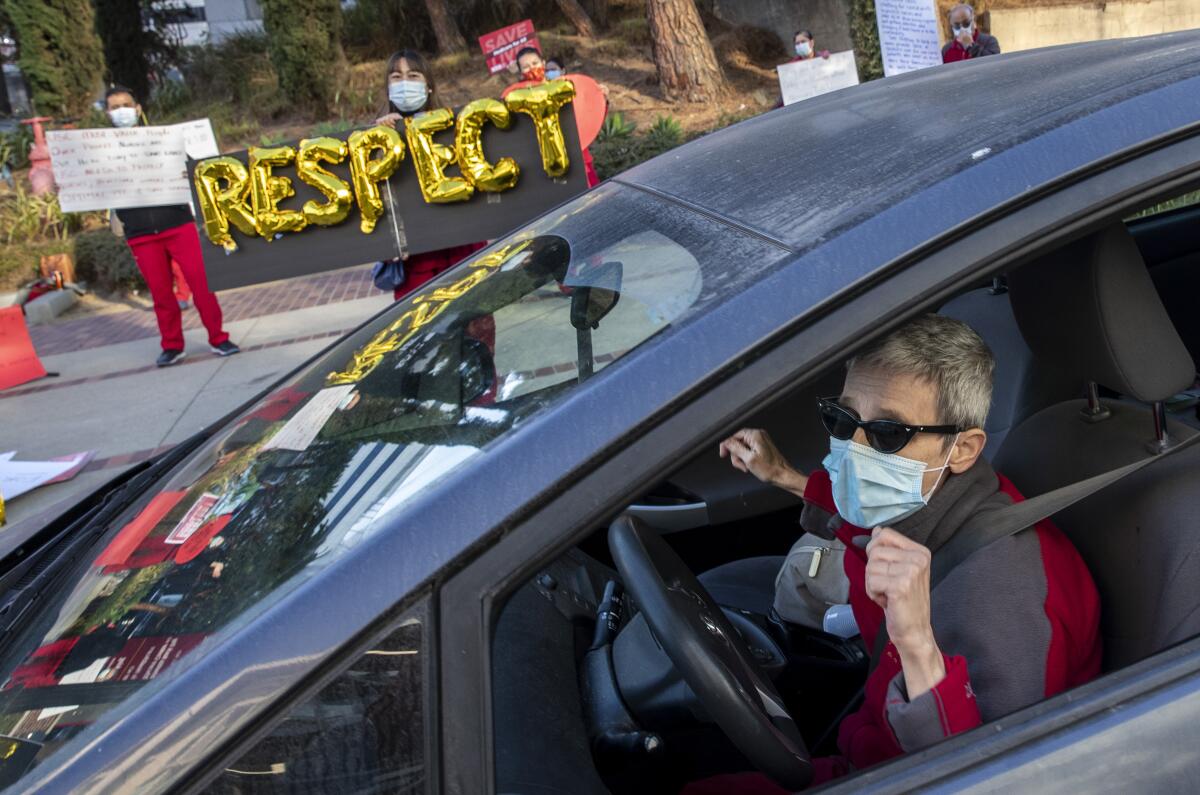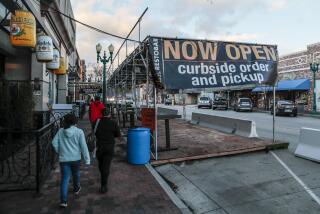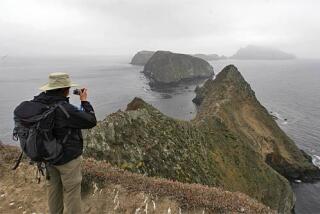What the stay-at-home order means for Southern California

- Share via
Southern California and the San Joaquin Valley will come under a new stay-at-home order beginning Sunday night after their available intensive care unit capacity fell below 15%, creating a critical shortage of ICU bed space in hospitals.
They will join several counties in the San Francisco Bay Area, which are planning to implement similar stay-at-home orders Sunday night and Monday morning, without waiting to cross into the threshold that would require action by the state.
By Tuesday, the stay-at-home orders will be in effect in 28 counties encompassing 84% of California’s population, affecting more than 33 million Californians.
When does the stay-at-home order go into effect?
The order goes into effect at these times in the following counties:
San Francisco, Santa Clara and Contra Costa counties: Sunday at 10 p.m.
Southern California region and the San Joaquin Valley: Sunday at 11:59 p.m.
Alameda County: Monday at 12:01 a.m.
Marin County: Tuesday at noon
How long does the order last?
For Southern California and the San Joaquin Valley, the order will last at least until Dec. 28 — and will only lift, at that time, if available ICU capacity projections for the following month reach 15% or greater.
The Bay Area orders are expected to remain in effect through Jan. 4, unless crowding in the region’s intensive care units improves earlier than anticipated.
How crowded are the intensive care units?
They’re getting more crowded than ever, and unless something is done to turn the tide, California’s intensive care unit capacity will be overwhelmed.
Mortality rates can dramatically increase when ICUs are stretched beyond capacity, and officials have already warned there are a limited number of doctors, nurses and other healthcare providers adequately trained in intensive care.
Quality of care can decrease substantially if hospitals are forced to transfer critically ill patients to other parts of the medical facilities that are not normally designed to care for such patients.
Nearly 20,000 Californians have died after being infected with the coronavirus, responsible for the worst global pandemic in more than a century. Unless the current surge in cases is turned around, California’s death toll could double by the end of winter.
Here’s a look at the remaining capacity of ICU wards in the five regions of California, as of Saturday, according to the the state Department of Public Health.
- Bay Area: 21.7%
- Greater Sacramento Region: 21.4%
- Rural Northern California: 24.1%
- Southern California: 12.5%
- San Joaquin Valley: 8.6%
When other regions’ ICU availability falls below 15%, as is expected this month, the state will order the stay-at-home order to take effect within 24 hours.
How does this stay-at-home differ from the spring one?
All retail stores will be allowed to remain open, at a reduced capacity, as will outdoor spaces like parks and beaches.
What closes once a region hits the threshold
- Outdoor restaurant dining
- Hair salons, barbershops, nail salons and other personal care services
- Playgrounds
- Outdoor cardrooms and satellite wagering and casinos
- Outdoor museums, zoos and aquariums
- Outdoor movie theaters
- Outdoor wineries
- Overnight stays at campgrounds
- Food, drink or alcohol sales at outdoor recreational facilities
Retail would stay open, but with limits
All retail would be allowed to remain open under this stay-at-home order, although at a reduced capacity. Counties can impose tougher rules than the state’s.
- Most of California: In much of the state, essential retail, like supermarkets and drug stores, were at 50% of capacity; nonessential retail, like other stores and malls, at 25%. The new order lowers capacity of all retail to 20%.
- Los Angeles County: L.A. County already had recently tightened capacity limits at retail. When L.A. County falls into the scope of the new order, nonessential retail capacity limits would remain the same at 20%. Essential retail capacity would fall from 35% of capacity to 20%.
- Santa Clara County: Santa Clara County also had already tightened capacity limits. When the county falls into the scope of the new order, the local, tougher limit for nonessential retail (10%) will be loosened to conform with the state’s limit, 20%. Essential retail capacity would fall from 25% to 20%.
- Shopping centers would also be capped at 20% of capacity. Eating and drinking in stores would be prohibited. Special hours should be imposed for seniors or those with compromised immune systems.
Use of hotels and lodging for tourism and leisure prohibited
After the first statewide stay-at-home order imposed in the spring, California allowed counties to reopen hotels for tourism and individual travel in June.
The new regional stay-at-home order, when effective, again prohibits hotel use for nonessential travel, whether it be a vacation or a road trip to see family or friends.
Specifically, it allows hotel and lodging for essential reasons only, defined as supporting “critical infrastructure sectors,” including workers in healthcare, food, agriculture, energy, utilities, transportation, communications, government operations, manufacturing, financial services and the entertainment industry.
What stays open
- Entertainment production
- Professional sports without live audiences, except for Santa Clara County. It has its own order banning contact sports, which has forced the San Francisco 49ers to temporarily relocate to Arizona for December home games
- Schools that are already open for in-person learning can remain open
- Outdoor areas like beaches, parks, and hiking trails
- Medical offices, dentist offices
- Child care and prekindergarten
- Restaurants for takeout and delivery service
- Critical infrastructure sectors
Gatherings would be banned
In early October, the state began to allow counties to permit small gatherings of people from different households, provided they occurred outdoors for no more than two hours and involved people from at most three households, who stayed at least six feet from one another and wore masks when not eating or drinking.
The new order would prohibit gatherings involving different households. L.A. County implemented the same ban Monday.
Outdoor church services and political demonstrations are still allowed.
How will the order be enforced?
The order will work only if most Californians comply.
Newsom said he’s seen support for enforcing the order from a number of local officials, although he acknowledged that some have said they’re not planning to enforce the rules. Newsom said he will withhold pandemic funds from counties unwilling to enforce rules or adopt measures to reduce the spread of disease.
Nonessential travel restricted
Once the order goes into effect, the state is asking people to stay at home and not mix and move around. Part of the recent surge in California was caused by travelers from out of state.
“All nonessential travel we are ordering to be temporarily restricted,” Gov. Gavin Newsom said.
The directive to cancel nonessential travel plans is a requirement, not an advisory. The requirement really isn’t enforceable, but Dr. Mark Ghaly, the California health and human services secretary, said he hoped that labeling it a requirement would encourage compliance. Why use a regional approach?
The regional approach is being used because that’s how hospitals and healthcare delivery systems work when some hospitals reach capacity, Ghaly said. When one county is full, it leans on a nearby county for help.
This is how the state’s regions are defined under the new order:
Rural Northern California: Del Norte, Glenn, Humboldt, Lake, Lassen, Mendocino, Modoc, Shasta, Siskiyou, Tehama, Trinity
Bay Area: Alameda, Contra Costa, Marin, Monterey, Napa, San Francisco, San Mateo, Santa Clara, Santa Cruz, Solano, Sonoma
Greater Sacramento: Alpine, Amador, Butte, Colusa, El Dorado, Nevada, Placer, Plumas, Sacramento, Sierra, Sutter, Yolo, Yuba
San Joaquin Valley: Calaveras, Fresno, Kern, Kings, Madera, Mariposa, Merced, San Benito, San Joaquin, Stanislaus, Tulare, Tuolumne
Southern California: Imperial, Inyo, Los Angeles, Mono, Orange, Riverside, San Bernardino, San Diego, San Luis Obispo, Santa Barbara, Ventura
More to Read
Sign up for Essential California
The most important California stories and recommendations in your inbox every morning.
You may occasionally receive promotional content from the Los Angeles Times.













